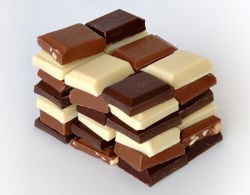Classification of Chocolate.

Chocolate is an extremely popular ingredient, and it is available in many types.
Different forms and flavours of chocolate are produced by varying the quantities of the different ingredients. Other flavours can be obtained by varying the time and temperature when roasting the beans.
Unsweetened chocolate is pure chocolate liquor, also known as bitter or baking chocolate. It is unadulterated chocolate: the pure, ground roasted chocolate beans impart a strong, deep chocolate flavour. With the addition of sugar, however, it is used as the base for cakes, brownies, confections, and cookies.
Dark chocolate is chocolate without milk as an additive. It is sometimes called "plain chocolate". The U.S. Government calls this "sweet chocolate", and requires a 15% concentration of chocolate liquor. European rules specify a minimum of 35% cocoa solids.
Milk chocolate is chocolate with milk powder or condensed milk added. The U.S. Government requires a 10% concentration of chocolate liquor. EU regulations specify a minimum of 25% cocoa solids.
Semisweet chocolate is often used for cooking purposes. It is a dark chocolate with high sugar content.
Bittersweet chocolate is chocolate liquor (or unsweetened chocolate) to which sugar, more cocoa butter, lecithin, and vanilla has been added. It has less sugar and more liquor than semisweet chocolate, but the two are interchangeable in baking. The best quality bittersweet and semisweet chocolates are produced as couverture; many brands now print on the package the percentage of cocoa (as chocolate liquor and added cocoa butter) contained. The rule is that the higher the percentage of cocoa, the less sweet the chocolate will be.
Couverture is a term used for chocolates rich in cocoa butter. Popular brands of couverture used by professional pastry chefs and often sold in gourmet and specialty food stores include: Valrhona, Felchlin, Lindt & Sprüngli, Scharffen Berger, Cacao Barry, Callebaut, and Guittard. These chocolates contain a high percentage of cocoa (sometimes 70% or more) and have a total fat content of 36-40%.
White chocolate is a confection based on cocoa butter without the cocoa solids.
Cocoa powder. There are two types of unsweetened baking cocoa available: natural cocoa (like the sort produced by Hershey's and Nestlé) and Dutch-process cocoa (such as the Hershey's European Style Cocoa and the Droste brand). Both are made by pulverising partially defatted chocolate liquor and removing nearly all the cocoa butter. Natural cocoa is light in colour and somewhat acidic with a strong chocolate flavour. Natural cocoa is commonly used in recipes which call for baking soda. Because baking soda is an alkali, combining it with natural cocoa creates a leavening action that allows the batter to rise during baking. Dutch-process cocoa is processed with alkali to neutralise its natural acidity. Dutch cocoa is slightly milder in taste, with a deeper and warmer colour than natural cocoa. Dutch-process cocoa is frequently used for chocolate drinks such as hot chocolate due to its ease in blending with liquids. Unfortunately, Dutch processing destroys most of the flavanols present in cocoa.
Flavours such as mint, orange, or strawberry are sometimes added to chocolate. Chocolate bars frequently contain added ingredients such as peanuts, nuts, caramel, or even crisped rice.

0 Comments:
Post a Comment
<< Home